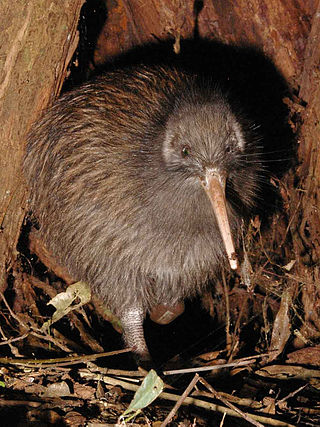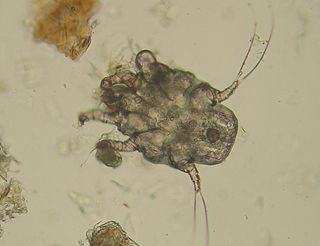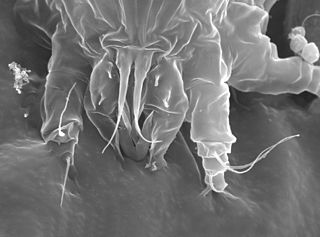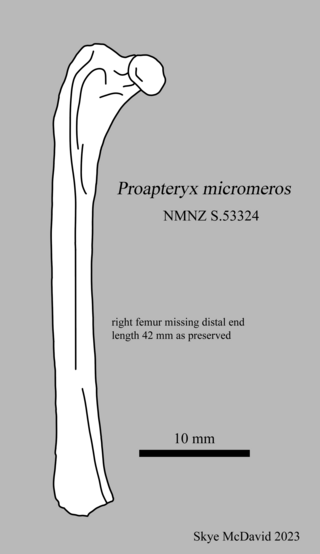
Kiwi are flightless birds endemic to New Zealand of the order Apterygiformes. The five extant species fall into the family Apterygidae and genus Apteryx. Approximately the size of a domestic chicken, kiwi are the smallest ratites.

A ratite is any of a group of mostly flightless birds within the infraclass Palaeognathae. They are mostly large, long-necked, and long-legged, the exception being the kiwi, which is also the only nocturnal extant ratite.

Mites are small arachnids. Mites span two large orders of arachnids, the Acariformes and the Parasitiformes, which were historically grouped together in the subclass Acari. However, most recent genetic analyses do not recover the two as each other's closest relative within Arachnida, rendering the group non-monophyletic. Most mites are tiny, less than 1 mm (0.04 in) in length, and have a simple, unsegmented body plan. The small size of most species makes them easily overlooked; some species live in water, many live in soil as decomposers, others live on plants, sometimes creating galls, while others are predators or parasites. This last type includes the commercially destructive Varroa parasite of honey bees, as well as scabies mites of humans. Most species are harmless to humans, but a few are associated with allergies or may transmit diseases.

Flightless birds are birds that, through evolution, lost the ability to fly. There are over 60 extant species, including the well-known ratites and penguins. The smallest flightless bird is the Inaccessible Island rail. The largest flightless bird, which is also the largest living bird in general, is the common ostrich.

The southern brown kiwi, tokoeka, or common kiwi is a species of kiwi from South Island, New Zealand. Until 2000 it was considered conspecific with the North Island brown kiwi, and still is by some authorities.

The great spotted kiwi, great grey kiwi or roroa is a species of kiwi endemic to the South Island of New Zealand. The great spotted kiwi, as a member of the ratites, is flightless. It is the largest of the kiwi. The rugged topography and harsh climate of the high altitude alpine part of its habitat render it inhospitable to a number of introduced mammalian predators, which include dogs, ferrets, cats, and stoats. Because of this, populations of this species have been less seriously affected by the predations of these invasive species compared to other kiwi. Nonetheless, there has been a 43% decline in population in the past 45 years, due to these predators and habitat destruction. This has led it to be classified as vulnerable. There are less than 16,000 great spotted kiwis in total, almost all in the more mountainous parts of northwest Nelson, the northwest coast, and the Southern Alps. A minority live on island reserves.

The little spotted kiwi or little grey kiwi is a small flightless bird in the kiwi family, Apterygidae. It is the smallest of the five kiwi species, at about 0.9 to 1.9 kg, about the size of a bantam. It is endemic to New Zealand, and in pre-European times occurred in both main islands, but is now restricted to a number of small offshore islands, and mainland reserves protected by pest-exclusion fences. The little spotted kiwi was on the brink of extinction when a conservation effort took place 100 years ago. Five individuals were translocated from the South Island of New Zealand to Kapiti Island. Today, the Kapiti Island population has grown, with around 1200 birds.

The Okarito kiwi, also known as the rowi or Okarito brown kiwi, is a member of the kiwi family Apterygidae, described as new to science in 2003. The species is part of the brown kiwi complex, and is morphologically very similar to other members of that complex. It is found in a restricted area of the Ōkārito forest on the West Coast of New Zealand's South Island, and has a population of only about 600 birds.

The North Island brown kiwi is a species of kiwi that is widespread in the northern two-thirds of the North Island of New Zealand and, with about 35,000 remaining, it is the most common kiwi. It holds the world record for laying the largest eggs relative to its body size.

Ixodes ricinus, the castor bean tick, is a chiefly European species of hard-bodied tick. It may reach a length of 11 mm (0.43 in) when engorged with a blood meal, and can transmit both bacterial and viral pathogens such as the causative agents of Lyme disease and tick-borne encephalitis.

Astigmatina is a clade of mites in the superorder Acariformes. Astigmata has been ranked as an order or suborder in the past, but was lowered to the unranked clade Astigmatina of the clade Desmonomatides in the order Sarcoptiformes. Astigmatina is now made up of the two groups Acaridia and Psoroptidia, which have been suborders of the order Astigmata in the past. Astigmatina contains about 10 superfamilies and 76 families under Acaridia and Psoroptidia.

The Proctophyllodidae are a family of the Acarina (mite) order Astigmata. They contain many feather mites. The Alloptidae and Trouessartiidae were in earlier times included here as subfamilies.

Floracarus perrepae is a species of herbivorous mite belonging to the family Eriophyidae. It is native to Australia (Queensland), China and New Caledonia. As it is known to attack and eat the invasive fern species Lygodium microphyllum, it is being considered for use as a biological pest control agent in Florida.

Dermanyssoidea is a superfamily of mites, including most of the mites which parasitise vertebrates.

Mites are small crawling animals related to ticks and spiders. Most mites are free-living and harmless. Other mites are parasitic, and those that infest livestock animals cause many diseases that are widespread, reduce production and profit for farmers, and are expensive to control.

Proapteryx micromeros is an extinct kiwi known from the 16–19 million-year-old early Miocene sediments of the St Bathans Fauna of Otago, New Zealand.
Kiwilichus is a genus of feather mites in Kiwilichidae, a monotypic family of mites that is endemic to New Zealand. Kiwi (Apteryx) are the host birds of the two species. Kiwilichus cryptosikyus is known to be hosted by southern brown kiwi and great spotted kiwi, and Kiwilichus delosikyus by southern brown kiwi.
Guntheria coorongensis is a species of mite in the family Trombiculidae, found from the tip of Cape York in Queensland to South Australia.
The Fiordland tokoeka or Fiordland kiwi is a subspecies of southern brown kiwi. It is endemic to New Zealand. Like other ratites, it is flightless.
Ixodes anatis, also called the kiwi tick, is a species of tick in the arthropod family Ixodidae. It is endemic to New Zealand and mainly parasitizes kiwi.
















